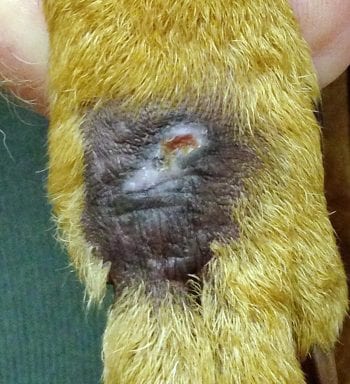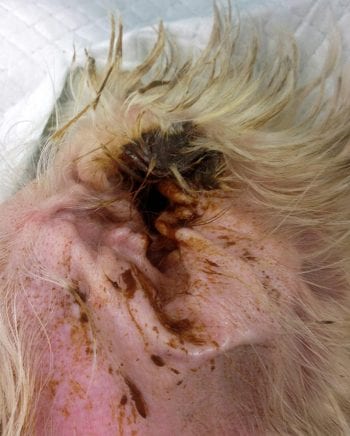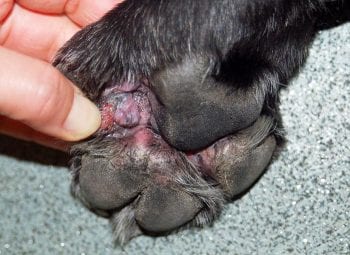29 Oct 2018
Ariane Neuber assesses prevailing types of allergy present in canine patients, suggesting diagnosis and management forms.

Dogs commonly suffer from allergic skin disease and the most common presenting sign for allergic patients is pruritus. However, pruritus is a very common presenting sign and is not specific for allergic skin disease.
It can be very frustrating to deal with, both for the attending vet and the owner. To deal effectively with pruritic patients, it is important to reach a diagnosis and use specific therapy to achieve the best clinical outcome.
Three main types of allergy are found in canine patients: flea allergic dermatitis (FAD), atopic dermatitis (AD) and adverse cutaneous food reaction (ACFR).
Contact allergy is less frequently seen. Many distinguishing features exist between FAD and AD/ACFR. However, clinically it is not usually possible to distinguish between AD and ACFR, although some clinical signs may make the clinician in charge more suspicious of one or the other.

FAD is not merely a flea infestation. It is the immune system’s overreaction to the presence of a small amount of allergen (flea saliva) injected during the flea bite. Due to the fleas’ preferences, a characteristic pattern of lesion distribution is usually seen.
Fleas feed from the caudal dorsum (the ”flea triangle”) and the ventrum in preference to other body regions, and, subsequently, this is where the lesions are usually located. However, lick granulomas affecting the hindlimbs (Figure 1) or perineal pruritus can also occur with this form of allergy. Facial pruritus and otitis is rare if no other allergies are present in the same patient.
The disease can be seasonal, in line with the seasonal variations in the flea populations. Autumn is often the starting point of the disease and, in many cases, the onset is slow and insidious. Depending on flea prevalence due to environmental factors and sensitivity, FAD often becomes non-seasonal over time. Dogs affected by other allergies are more likely to develop sensitivity to flea bites than dogs not suffering from other allergies.
Canine AD (CAD) has been defined as a genetically predisposed inflammatory and pruritic allergic skin disease with characteristic clinical features associated with IgE antibodies to environmental allergens (Halliwell, 2006). Lesion distribution typically involved the face, ears, paws and ventrum.
AD is a diagnosis of exclusion, with parasitic diseases such as sarcoptic mange (Figure 2) or demodectic mange (Figure 3), food allergy, and flea allergy being the main differentials. Allergic skin disease is often complicated by secondary infections with either bacteria (most commonly Staphylococcus pseudintermedius) or yeast (usually Malassezia pachydermatis) overgrowth or infection (Figure 4), and this can change the clinical appearance somewhat.
ACFR cannot clinically be distinguished from atopic dermatitis as the presenting signs are very similar. However, it can also present with a more dorsal pattern, much like FAD.

Around one-third of dogs suffering from ACFR also show gastrointestinal signs, such as recurrent colitis, increased frequency of defecation, increased flatulence, faecal tenesmus, anal/perineal or facial irritation, or accidents in the house. Dogs suffering from otitis alone (Figure 5) – with no other dermatological signs – suffer more commonly from ACFR than AD.
Due to various factors it is difficult to determine the true prevalence of allergic skin diseases. Firstly, geographical variations will exist. Secondly, the prevalence will change over time as environmental factors play a role in the aetiology. Thirdly, many manifestations of allergic skin disease are likely not to be recognised by the owner and vet as a sign of an allergy, such as otitis, or secondary infections that fully respond to antimicrobial therapy.
In addition, many patients are only very mildly affected and most likely do not require veterinary intervention, but are maintained by simple measures, such as appropriate flea control, in combination with regular shampooing and ear cleaning without the owners noticing a mild allergy is present. No definitive laboratory tests give a black and white answer along the lines of allergic/not allergic.
Nonetheless, canine allergic skin diseases account for a high percentage of cases in general practice. Pruritus was the most common presenting sign in one study, with 30% to 40% of canine patients affected by it (Hill et al, 2006). The same study found allergic skin disease as the aetiological diagnosis in around 10% of cases presenting with dermatological signs.
Early reports (Chamberlain, 1974) estimated the prevalence of AD in the canine population at large to be 15%. Textbooks quoted estimates of 3% (Reedy et al, 1997) to 15% and around 10% (Scott et al, 2001).
For ACFR, a study (Olivry and Mueller, 2017) cited the prevalence among dogs presented to the vet for any disease as 1% to 2% and for dermatological disease as 0% to 24%. In dogs presenting for pruritus this varied between 9% to 40%, in dogs with cutaneous signs in general 8% to 63% and in dogs with AD 9% to 50%. At any rate, the conclusion was performing a dietary elimination trial is worth pursuing to eliminate the diagnosis of ACFR before diagnosing AD.
FAD is often considered to be more common than other types of allergic skin disease; however, this depends very much on geographical variation, the method of diagnosis and with the advent of better flea control it changes with time.

As the lesion distribution in cases of FAD is very distinctive, patients with caudodorsal pruritus are very suspicious of this diagnosis and trial anti-parasitic therapy is indicated. However, certain breeds (such as Shar Pei and West Highland white terrier) also show a caudo-lumbar lesion distribution when affected by CAD and this needs to be borne in mind (Wilhelm et al, 2011).
Even in cases with suspected allergies of other origin, the diagnostic approach should always incorporate very thorough flea control, ideally with a product that can reliably rule out scabies, to avoid missing fox mange, and identify ectoparasites as a contributing factor and reduce the risk of parasites acting as flare factors for dogs with CAD.
Secondary infections are a common factor in a variety of skin diseases, such as allergic skin disease, ectoparasites, endocrine disease and autoimmune disease. They are pruritic in their own right and can alter the appearance of the primary disease. It is, therefore, important to investigate this possibility and treat accordingly.
As ACFR looks clinically identical to CAD without a food component, it is worth performing a food trial prior to making a diagnosis. Although serum food allergy tests are marketed, their use is limited according to a review study (Mueller and Olivry, 2017). The results show a highly variable accuracy and low repeatability in dogs. Patch testing was found to have a high negative predictive value, making it an option to help chose the allergens for an exclusion diet; however, keeping patch test chambers in place is not very practical and not commonly done in small animal practice.
CAD is a diagnosis of exclusion of plausible differentials. A pruritic canine patient that is on suitable parasite control, has been investigated and, if needed, treated for secondary infections and has got compatible historical and clinical signs consistent with CAD can be diagnosed with atopic dermatitis. Allergy testing, be it allergen-specific serum IgE testing, intradermal allergy testing or prick testing, merely identifies the offending allergens to formulate allergen-specific immunotherapy, if this form of therapy is deemed suitable for the patient in question.
1. Age at onset under three years.
2. Mostly indoor.
3. “Alesional” pruritus at onset.
4. Affected front feet (Figure 6).
5. Affected ear pinnae.
6. Non-affected ear margins.
7. Non-affected dorsolumbar area.
If five criteria are fulfilled: sens 77.2%, spec 83%.
If six criteria are fulfilled: sens 42%, spec 93.7%.
Favrot et al (2010) published criteria that help make the diagnosis (Panel 1). These criteria needs to be viewed as one of many tools, rather than the only diagnostic aid.
FAD is best controlled with good flea control and ACFR required dietary restriction, excluding the offending food allergen. In CAD, due to environmental allergens, allergen avoidance is unlikely to be successful. Certain measures can reduce the allergen load in the environment; however, complete elimination of the offending allergen is not very practical to achieve.
Therefore, once a diagnosis of CAD has been made, it is important to discuss a number of facts with the owners. Firstly, they need to be made aware his or her dog is suffering from a life-long disease and will, therefore, require some form of therapy for the rest of its life. Secondly, CAD is a manageable disease and good quality of life can be achieved in the majority of cases. A number of treatment options are available and, usually, a multimodal approach is most successful.
The main objective is usually to achieve the best possible quality of life, while minimising the risk of side effects. A one-size-fits-all approach does not work for many cases and the treatment needs to be tailored individually. A preventive approach, such as stopping flares, is usually more successful – rather than taking a reactive approach where treatment is discontinued until a deterioration occurs, which prompts another visit to the vet and requires therapy.
Flare factors include secondary infections, ectoparasites, environmental factors and stress, and should be avoided if possible.
The multimodal approach can include treatments aimed at various factors of CAD:
It is useful to distinguish between treatment of acute flares and management of the chronic inflammation driving the acute flares. The former needs to consist of fast-acting anti-inflammatory/anti-pruritic therapies, as well as potential antimicrobial treatments. The latter is aimed at mid-term to long-term avoidance of flares by reducing the inflammatory state the patients find themselves in. Both strategies are important and need to be pursued hand-in-hand to be successful.
If only flares are managed, the owners are likely to become frustrated as they have to keep going back to ”put out the fire”. If only long-term treatment strategies are pursued, without dealing with acute flares, a potentially unjustified perceived lack of efficacy will occur as these strategies take a long time to take full effect.
Canine allergic skin diseases are very commonly seen in practice. They are life-long diseases and require ongoing therapy.
The most successful treatment strategies usually incorporate multiple treatment modalities to minimise side effects, while maximising quality of life for the patient and owner.